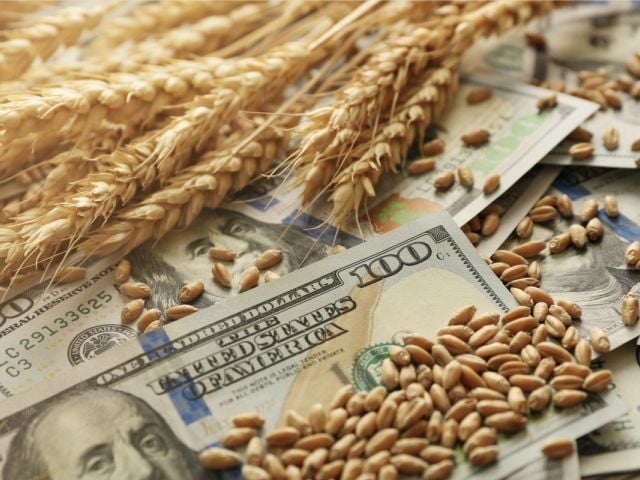
There’s a lot of doom and gloom in the air about the state of the farm economy. As commodity prices continue to fall from the historic highs of the last few years, advocates for the agriculture industry have been claiming that growers will have a hard time making ends meet. The House Agriculture Committee has held hearings to “focus on the farm economy,” inviting witnesses from Big Ag to declare that the sky is falling.
Some farm families are indeed suffering and Congress should make sure they get the help they need as crop prices return to more typical levels. But in the meantime, the woefully broken and inept federal farm subsidy programs keep sending most of the money to the most financially secure and prosperous farm businesses, whether they need help or not. Since 1995, fully 77 percent of subsidy dollars have gone to just 10 percent of all recipients, most of them members of complex partnerships and joint operations who may never set foot on a farm – let alone drive a tractor.
With the farm subsidy lobby gearing up to push for even more billions in federal largesse, it’s a good time to take a hard look at the truth about the financial health of the farm sector.
Prices Are Returning to Normal Levels
It’s true that commodity prices for crops like corn and soybeans have been dropping over the last few years, but today’s prices are simply declining from what were historic highs. From 2008 to 2014, corn, soybean and wheat prices were the highest ever (Figure 1). Current prices are still mostly above the level of the mid-2000s, and are much higher than in the 1900s.
Figure 1: Corn, soybean and wheat prices were abnormally high from 2008 to 2014.
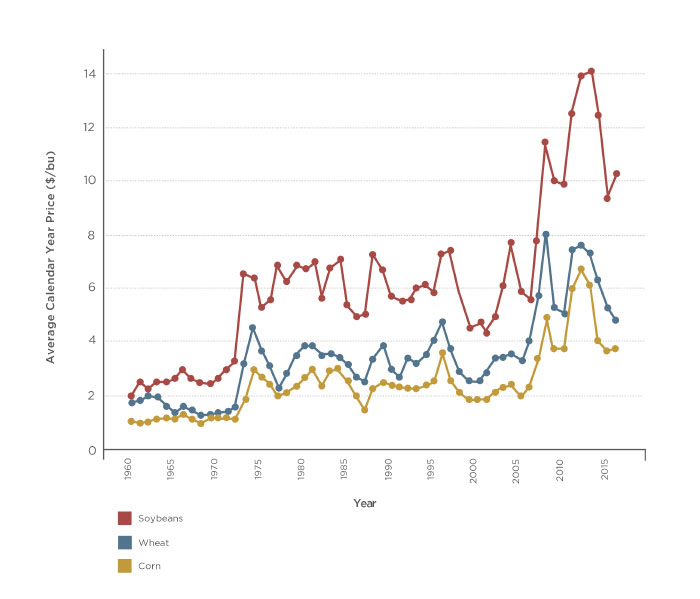
Source: EWG, from Farmdoc, US Average Farm Price Received Database, Department of Agricultural and Consumer Economics, University of Illinois at Urbana-Champaign.
Farm Households Are Better Off Than Non-Farm Households
Despite the recent drops in crop prices, farm households’ income this year is expected to be significantly higher than that of non-farm households. The Department of Agriculture projects that median farm household income will reach $83,255 in 2016, higher than in any other year on record. This is remarkably more than overall median U.S. household income. In 2014, the most recent for which data are available, overall median household income was $53,657. Median farm household income that year was $81,637 – almost $28,000 more.
Farm household income includes all crops and animal products (such as livestock and dairy), indicating that it is not only grain growers who are doing well. And farm household income is continuing to rise, even though net income from agricultural operations is projected to decrease slightly. That’s because the majority of farm households earn much of their income from off-farm sources. Small farms with less than $350,000 in annual farm income make up almost 90 percent of all farms, and they get almost all of their income from off-farm sources.
Only a small fraction of growers truly depends on farm income for their livelihoods, and these are almost always large farms or farm businesses that are doing quite well (Figure 2). In 2014, annual household income was over $350,000 for farm businesses that rely the most on farming for their income. These are, of course, the very farm businesses that harvest the vast majority of government subsidies.
Figure 2: Ninety percent of farms are small and depend mostly on off-farm income.
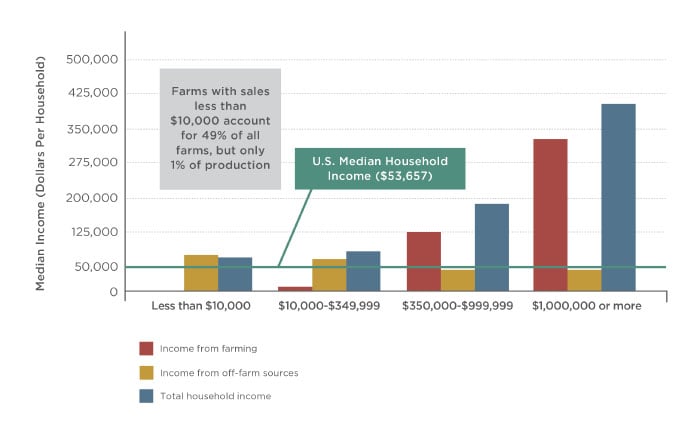
Source: USDA Economic Research Service, “Most farmers receive off-farm income, but small-scale operators depend on it,” September 16, 2013.
Farm Sector’s Financial Health is Still Strong
One widely used measure of a business’ financial health is its debt-to-asset ratio, which compares the amount of debt it’s carrying to the value of its assets. A low ratio means the value of the assets is far greater than its debt. Businesses with debt-to-asset ratios of 40 percent or less are much healthier financially than those with higher ratios. Banks often consider a farm’s debt-to-asset ratio when making lending decisions, so they are very important to growers.
Although the farm sector’s debt-to-asset ratio is expected to increase moderately in 2016, it is still at a remarkably low 13.23 percent, well below the 40 percent threshold and a strong indicator that growers are still doing well financially. Moreover, agriculture’s debt-to-asset ratios over the last decade have been lower than for most proceeding years (Figure 3).
Figure 3: Farm sector’s debt-to-asset ratio is still much lower than in most years 1970-2005.
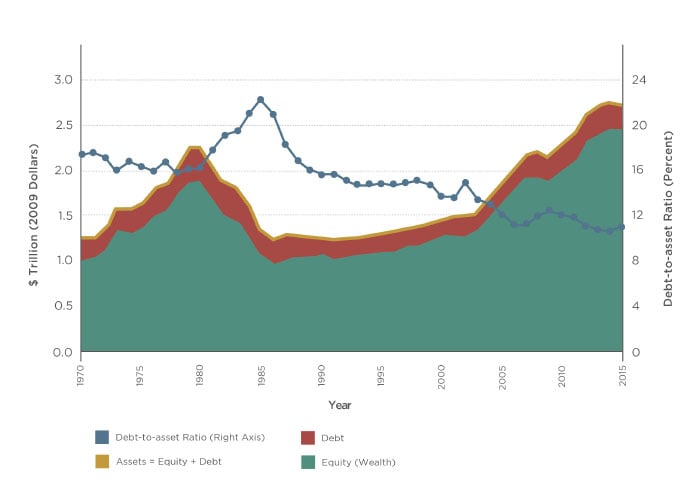
Source: USDA Economic Research Service, “U.S. farm sector assets and equity (inflation-adjusted) forecast to decline in 2015 for the first time since 2009,” March 2, 2015.
The loan delinquency rate, which is the number of delinquent loans divided by the total quantity of loans, is also a good measure of financial health. The delinquency rate for farm loans in 2015 was markedly below the 15-year average. At the end of 2015, the non-real estate farm loan delinquency rate was below 1 percent, and the farm real estate delinquency rate was only 1.5 percent. Both measures of farm loans are well below the national delinquency rate for all loans, which was over 2 percent in 2015 (Figure 4). Despite falling crop prices, most growers are still able to pay off their loans.
Figure 4: Farm loan delinquency rates are below the rates for all loans.
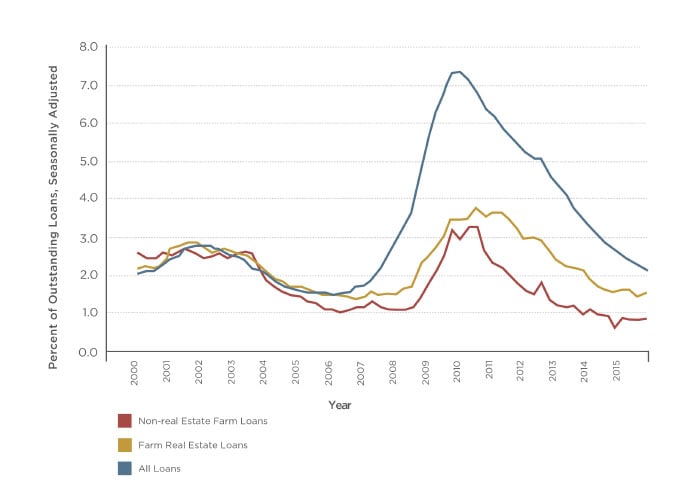
Source: Kauffman, N. “Farm Lending Activity Remains Robust.” Ag Finance Databook, Federal Reserve Bank of Kansas City, April 25, 2016
‘Other’ Agriculture is Doing Well
Most of the discussion of the drops in commodity prices has focused on the grain crops that collect the most farm subsidies. But there is much more to the U.S. agriculture sector than grains. Corn, soybean and wheat combined, for example, accounted for only 26 percent of farm cash receipts in 2014. Sales of livestock, dairy, fruits, vegetables and nuts produced fully 62 percent of all farm cash receipts. (Figure 5).
Figure 5: Half of farm cash receipts come from livestock and animal products.
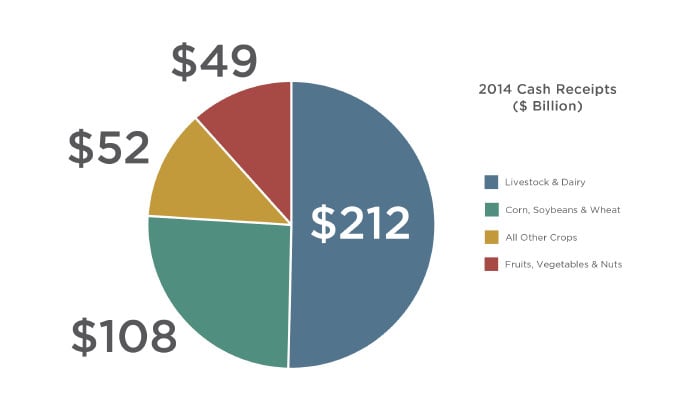
Source: EWG, from USDA Economic Research Service, “Cash receipts for corn and soybeans accounted for close to half of all U.S. crop receipts in 2014” and USDA ERS, “Cattle/calves receipts accounted for nearly 40 percent of U.S. animal/product receipts in 2014,” February 9, 2016
Most agriculture sectors did not enjoy the same historic increase in prices as grains did from 2008 to 2014. On the other hand, their prices aren’t falling nearly as much now as are corn, soybeans, wheat and other grains as they retreat from those historic highs.
In 2016, receipts for fruits and nuts are projected to be higher than they were from 2012 to 2014. Receipts for vegetables and melons are expected to fall 7 percent from 2015’s levels but will still be well above 2012’s. Receipts for dairy and hogs are forecast to fall 6 percent and 5 percent respectively from 2015 levels, while receipts for cattle and calves as well as broilers are forecasted to be 11 and 14 percent higher than in 2012.
Any assessment of the health of the farm economy must consider all sources of farm income, not just those favored crops that gorge on billions of dollars in federal subsidies.
Farm Crisis?
The farm subsidy lobby is working overtime to use what it calls a “farm crisis” to deflect well-deserved criticism of the fatally flawed federal subsidy system that they’re desperate to protect. Current economic conditions, however, are nowhere near those of the real farm crisis in the 1980s. The farm businesses that collect the lion’s share of subsidies are not doing nearly as badly as the industry argues, especially compared to the rest of America’s families.
The federal farm subsidy system is badly broken. Help should be going to those families that depend on their farms for income and are struggling to stay afloat as production and land costs react to lower crop prices. But that’s not what’s happening.
Policymakers should ignore the subsidy lobby as it beats the drum for more and more taxpayer dollars and focus instead on fundamental reform of these programs so as to help those farm families in greatest need.
